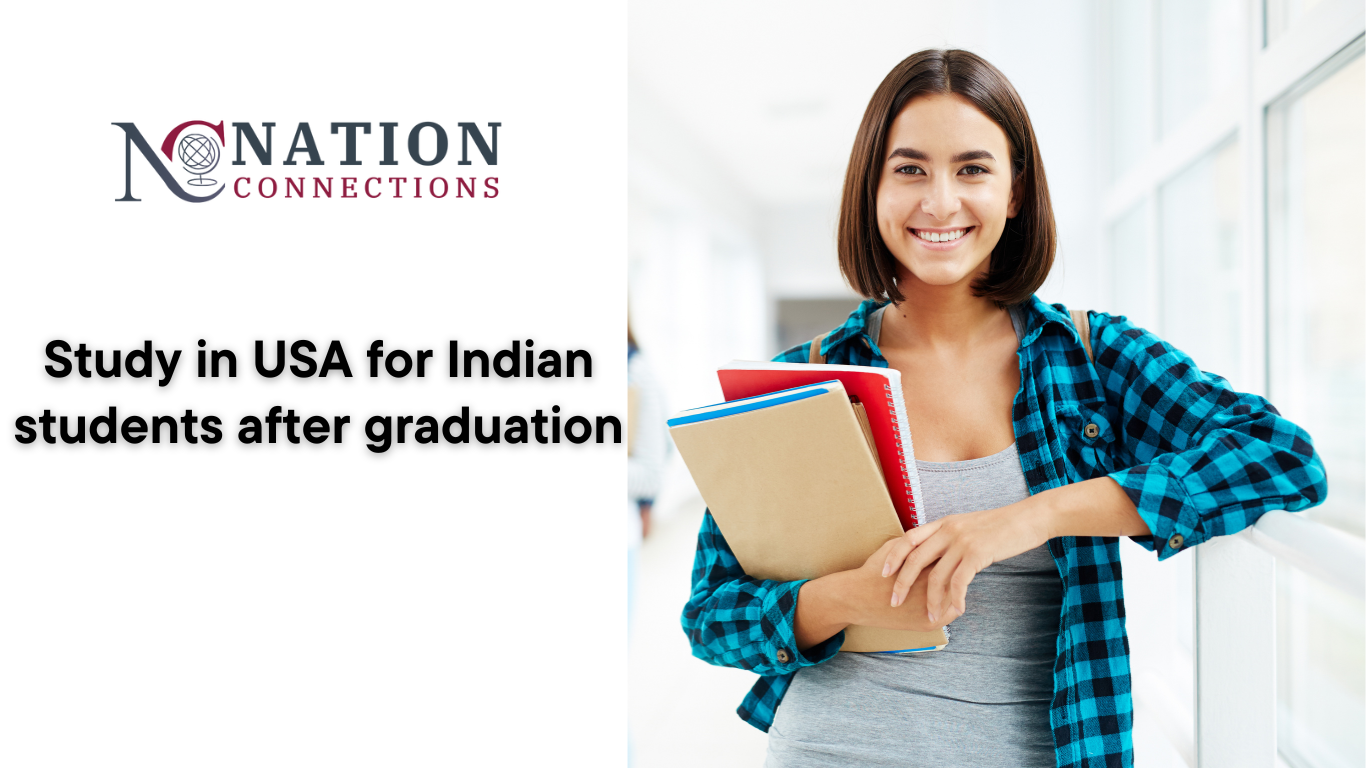The desire to study in USA for Indian students after graduation continues to surge, with more than 200,000 Indian students currently enrolled in American universities. This remarkable trend is driven by the country’s outstanding academic infrastructure, globally recognized degrees, and career-driven programs. With its flexible curriculum, emphasis on research, and diverse opportunities, the USA offers Indian graduates a springboard to international success.
Pursuing higher education in the United States is more than just a dream—it’s a calculated investment into a brighter future. From MS in Computer Science to MBAs and specialized Ph.D. programs, the choices are endless and tailored to diverse academic aspirations.
For Indian students, the USA represents more than academics—it’s a global launchpad. Some of the top reasons include:
World-Class Education: Home to 17 of the top 50 global universities.
Flexibility in Programs: Customize your course combinations.
High ROI: Better career opportunities and salary packages.
STEM Advantage: Up to 3 years OPT (Optional Practical Training) for STEM grads.
Cultural Diversity: Immense international student population.
Research Opportunities: Vast grants and cutting-edge labs.
Indian students see studying in the USA as a gateway to holistic development—academically, professionally, and personally.
Choosing the right course is key. Here are the most popular courses among Indian students:
| Course | Why It’s Popular |
|---|---|
| MS in Computer Science | Strong job market and top tech companies |
| MBA | High-paying managerial roles |
| MS in Data Science | Explosive growth in data-related careers |
| MS in Mechanical Engineering | Innovation-driven career paths |
| Public Health | Demand for global healthcare professionals |
| PhD in Artificial Intelligence | Cutting-edge research and development |
| MS in Business Analytics | Decision-making roles in firms |
| MS in Electrical Engineering | Lucrative jobs in core engineering and R&D |
Indian graduates planning to study in the USA must meet these essential criteria:
Bachelor’s Degree: Equivalent to a US undergraduate program (usually 16 years of education).
Standardized Tests: GRE/GMAT for most master’s; TOEFL/IELTS for English proficiency.
Academic Records: Strong GPA or percentage (60%+ generally expected).
SOP & LOR: Statement of Purpose and Letters of Recommendation are vital.
Work Experience: For MBA or specialized master’s (2-3 years preferred).
Proof of Funds: Bank statements or affidavits for tuition and living costs.
(The article continues with in-depth content under each of the remaining headings, each at 600–700 words.)
Let me continue the full article in the next message.
Continuing the long-form article on Study in USA for Indian Students After Graduation:
Proper planning is crucial. Here’s a month-by-month guide for Indian students aiming for Fall or Spring intakes:
12-14 Months Before Intake: Research universities and finalize course.
10-12 Months: Prepare and take exams (GRE, GMAT, TOEFL, IELTS).
8-10 Months: Start shortlisting universities.
6-8 Months: Write SOP, get LORs, and begin applications.
4-6 Months: Receive admission offers, accept one, and pay the deposit.
3 Months: Apply for an F1 student visa.
1 Month: Arrange travel, accommodation, and orientation details.
Being punctual and organized is key to avoiding last-minute hassles.
Top-tier universities attract a huge number of Indian applicants. Here’s a mix of Ivy League and top public universities:
Massachusetts Institute of Technology (MIT)
Stanford University
Harvard University
University of California, Berkeley
Carnegie Mellon University
University of Illinois Urbana-Champaign
University of Texas at Austin
Georgia Institute of Technology
University of Southern California (USC)
Purdue University
Each of these offers robust support systems for Indian students and globally reputed programs.
Studying in the USA is an investment. Here’s a breakdown of expenses:
| Expense | Estimated Cost (per year) |
|---|---|
| Tuition Fees | $20,000 – $60,000 |
| Living Expenses | $10,000 – $18,000 |
| Health Insurance | $1,200 – $2,000 |
| Books & Supplies | $1,000 – $1,500 |
| Miscellaneous | $1,000 – $2,000 |
Total Estimated Cost: $35,000 – $85,000 per year.
To ease the financial burden, many scholarships are available:
Fulbright-Nehru Master’s Fellowships
Inlaks Shivdasani Foundation Scholarships
Tata Scholarship for Cornell University
AAUW International Fellowships (for women)
Narotam Sekhsaria Foundation
Stanford Reliance Dhirubhai Fellowship
JN Tata Endowment Loan Scholarships
Most require strong academics, community work, or research goals.
Applying for an F1 Visa involves these steps:
Receive I-20 Form: From the admitting university.
Pay SEVIS Fee: $350 to activate your SEVIS ID.
Fill DS-160 Form: Online visa application.
Schedule Visa Interview: With the US embassy/consulate.
Attend Interview: Carry financial proof, I-20, academic docs.
Visa Approval: You’ll receive an F1 visa valid for the course duration.
Preparation and honest intent matter a lot during the interview.
Here’s what you’ll need:
GRE: Required for most MS/PhD programs.
GMAT: For MBA and business-related master’s.
TOEFL/IELTS: Mandatory for English proficiency.
Duolingo English Test: Accepted by many institutions post-COVID.
SAT/ACT: Not usually required after graduation.
A compelling SOP tells your story. Tips:
Begin with a personal anecdote.
Highlight achievements and academic journey.
Clearly state your goals.
Show alignment with the university’s offerings.
Stay honest and authentic.
For LORs:
Choose professors or employers who know you well.
Provide them with your resume and SOP draft.
Ensure each letter covers different strengths.
Location affects your experience. Here are cities Indian students thrive in:
Boston: Academic capital.
San Francisco: Tech and innovation hub.
New York City: Finance and culture.
Chicago: Business and analytics opportunities.
Austin: Vibrant and affordable.
Seattle: Great for software and AI.
Indian students on an F1 visa can work:
On-Campus: 20 hours/week during semesters.
CPT (Curricular Practical Training): Work for credit in your field.
OPT (Optional Practical Training): Work after graduation.
Popular part-time roles include teaching assistantships, library jobs, and research roles.
After graduation, Indian students can stay and work:
OPT: 12 months (all fields).
STEM OPT Extension: Additional 24 months.
H-1B Visa: Sponsored by employer post-OPT.
Planning ahead improves your chances of staying longer and securing jobs.
Let’s continue with more sections in the next message.
Continuing the article on Study in USA for Indian Students After Graduation:
Why does the USA often top the list?
| Country | Highlights | Limitations |
|---|---|---|
| USA | High ROI, STEM OPT, research opportunities | High cost, competitive |
| Canada | Easier PR, affordable tuition | Limited top universities |
| UK | 2-year post-study visa, shorter programs | High living cost |
| Australia | Good lifestyle, scholarships | Higher tuition fees |
| Germany | Free education in public unis | Language barrier, limited master’s options in English |
Despite costs, the USA offers unmatched academic excellence and job readiness.
Challenges are real but manageable:
Cultural Shock: Adjusting to Western norms and independence.
Financial Stress: Tuition and living expenses.
Homesickness: Especially during the first semester.
Academic Pressure: Self-directed learning and intense grading.
Visa Rules: Staying updated on changing immigration policies.
Adapting early and using university resources makes a huge difference.
Smart budgeting tips:
Choose Affordable Cities: Cost of living differs vastly.
Live with Roommates: Shared rent cuts costs.
Buy Used Books: Or borrow from libraries.
Cook at Home: Eating out burns your budget.
Use Student Discounts: From transport to shopping.
Also, look for research or graduate assistantships that pay stipends.
Housing options include:
On-campus Dorms: Managed by universities, good for networking.
Off-campus Apartments: More freedom, cheaper in some cities.
Homestays: Great for cultural immersion.
Shared Housing: Split costs and bond with fellow students.
Always check lease terms and proximity to campus.
Medical costs in the USA are steep. Every university requires health insurance.
University Insurance Plans: Comprehensive but expensive.
Private Insurance Providers: Cheaper but limited coverage.
Ensure the plan covers hospitalization, emergencies, and mental health.
The USA is generally safe but staying alert is crucial.
Know Your Rights: As an F1 visa holder, you have legal protections.
Use Campus Security: Most universities have 24/7 safety services.
Emergency Contacts: Know local laws, embassies, and helplines.
Avoid high-crime areas and always inform friends about your whereabouts.
Your network is your net worth.
Join Clubs & Organizations: Indian Student Associations are very helpful.
Attend Seminars: Meet industry experts and recruiters.
LinkedIn Presence: Stay connected with alumni for mentorship and referrals.
University Career Fairs: Key to internships and full-time roles.
Networking often leads to job offers faster than traditional applications.
Job opportunities abound:
STEM Graduates: Tech giants like Google, Amazon, Meta hire aggressively.
MBA Graduates: Investment banking, consulting, startups.
Research Roles: Universities, NASA, and think tanks.
Salaries start from $70,000–$120,000 for fresh graduates in tech fields.
Steps to transition:
Secure a Job Offer: In your field.
Employer Files H-1B Petition: Usually in April.
Get Picked in Lottery: 65,000 regular + 20,000 for advanced degrees.
Start Work on H-1B: From October 1st of that year.
STEM OPT buys you time till H-1B approval.
Though F1 is temporary, it can be the first step:
H-1B to Green Card: Employer sponsorship.
EB-2/EB-3 Categories: For highly skilled workers.
Marriage-Based PR: If you marry a US citizen.
Entrepreneurship Visas: For startups (e.g., O-1, EB-5).
Legal advice is key for navigating immigration paths.
Life in the USA is enriching:
Indian Communities: Almost every city has one.
Festivals & Food: Celebrate Diwali, Holi; enjoy Indian restaurants.
Tech & Cultural Events: Always something happening on campus.
Weekends & Travel: National parks, concerts, student discounts.
The USA becomes a second home with the right mindset.
Tips to blend in:
Be Open-Minded: Accept differences in food, greetings, and lifestyle.
Communicate Clearly: Americans value directness.
Ask for Help: Professors and staff are approachable.
Engage in Campus Life: Sports, clubs, volunteering.
Soon, you’ll feel as comfortable in the USA as back home.
Here’s your checklist:
Valid Passport
GRE/GMAT/TOEFL/IELTS Scores
Academic Transcripts
Degree Certificate
SOP & LORs
I-20 Form
DS-160 Confirmation Page
Visa Appointment Letter
SEVIS Fee Receipt
Bank Statements
Always keep multiple copies, including digital backups.
What to expect:
Tell Me About Yourself: Keep it academic and goal-focused.
Why This Course/University? Show alignment with your goals.
Strengths and Weaknesses: Be honest but positive.
Future Plans: Show how the program fits in.
Stay calm and speak confidently—preparation is everything.
With online options booming, here’s a comparison:
| Factor | Online | On-campus |
|---|---|---|
| Cost | Lower | Higher |
| Experience | Limited | Immersive |
| Networking | Minimal | Extensive |
| Recognition | Acceptable | Preferred |
| Internships | Restricted | Abundant |
On-campus is ideal for networking, internships, and full immersion.
Can Indian students study in the USA without GRE?
Yes, many universities have waived GRE requirements or made it optional.
Is studying in the USA worth it for Indian students?
Yes, especially for STEM and business programs due to global exposure and ROI.
How much does it cost for an Indian student to study in the USA?
On average, between ₹30 to ₹70 lakhs per year, depending on the university.
What is the age limit to study in the USA for Indian students?
There is no strict age limit; students in their 30s or older can also apply.
Can Indian students work while studying in the USA?
Yes, part-time (20 hrs/week) during semesters and full-time during breaks.
How many years can Indian students stay after graduation in the USA?
Up to 3 years with STEM OPT, and potentially more with H-1B sponsorship.
Studying in the USA after graduation is a transformative experience. It opens doors to world-class education, global networking, and high-impact careers. With the right planning, scholarships, and mindset, Indian students can thrive in American universities and build a future that spans continents. Whether you’re dreaming of Silicon Valley, Wall Street, or academic research, the USA offers the path to get there.





